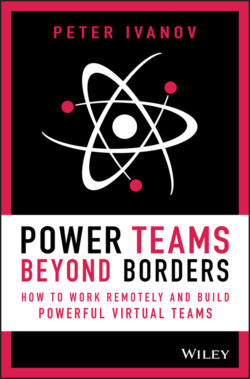Читать книгу Power Teams Beyond Borders - Peter Ivanov - Страница 13
How to Start Building Trust in Your Team
ОглавлениеThere are two exercises you can complete with your team to start building those personal connections.
The first is to get everyone in your team to create a lifeline, a sort of timeline of their lives, that includes their highlights and lowlights. These moments don't have to be professional, they can be personal in nature, too. You can ask people to create just one lifeline, or you can ask them to create two, one for professional moments and one for personal ones.
You'll be amazed at how much you can learn about one another in five to ten minutes alone by completing this exercise. I've run this exercise with teams who have been working together for five or even ten years in some cases, and they've learned more about each other during this lifeline exercise than they have in all those previous years of interacting almost daily.
When people explain their lifelines to the rest of the team, you'll learn what makes their heart sing. This sows the seeds for those all‐important interpersonal relationships to grow and blossom.
I also tell everyone to bring one photo that they identify with and to share this with the rest of their team. You know the old saying, ‘A picture is worth 1,000 words’? It's true.
More and more companies are creating virtual teams who are based all over the world. It allows them to access the best talent out there. But when you're not able to meet face to face, you need to find other ways of building those vital personal relationships and this exercise is a brilliant way to do that.
If you work with a very big team, you can still complete the lifeline exercise. To make sure it doesn't last too long, and that everyone is able to share something about themselves, I have a fast‐paced format that you can use instead. Ask everyone to answer the following four questions:
1 Do you have siblings? If so, how many and are they older or younger than you?
2 What hobby were you most passionate about as a child?
3 What are you most proud of?
4 What else should other people know about you?
The aim with these four questions is to provide a small amount of information that people can relate to. The answers people give will spark further conversations, and that's the whole point of this exercise. You can also start to build up a picture of someone based on their answers to these questions.
For example, if they're the oldest sibling in a family they may have taken on a leadership role early in their lives. As the youngest in a family, they may be competitive because they've been trying to keep up with their older siblings. Middle children are often considered to be adaptable, while only children might not be used to sharing.
The first two questions should be easy for anyone to answer and are like a warm‐up. The third question is likely to be the one that people need to give the most thought to. And with the fourth question, I'd encourage people to share something exotic, something really unique. These last two questions deliberately encourage people to be vulnerable, to show that less polished side of themselves.
I'll share my answers to these questions so that you can get to know me a little:
1 I have an older brother who lives in Australia (I live in Hamburg, Germany), and he's six years older than me.
2 I used to draw pictures of horses. Usually these were galloping horses being ridden by Native Americans.
3 I'm most proud of my five daughters; they are the apples of my eye.
4 The other thing you should know about me is that I like to throw things over long distances. I was actually the World Champion discus thrower at the competition in Auckland in 2017, and I also took home a bronze medal in the men's over‐45 age group javelin competition.
